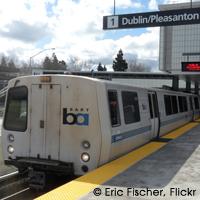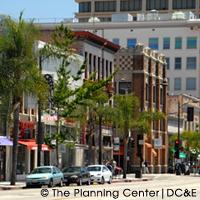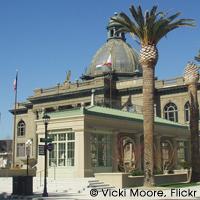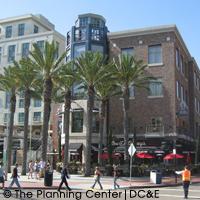West Dublin BART
 The West Dublin Bay Area Rapid Transit
(BART) station opened in February 2011 after a nearly 15-year
effort to fund and construct the station. The station is in
suburban Alameda County, on the border between the towns of
Dublin and Pleasanton. The West Dublin station was completed as
an “infill” station between the Dublin/Pleasanton and Castro
Valley stations, a ten-mile stretch of the BART line with no
stops. The construction of the West Dublin Station provides a
unique example of using joint development as a value capture
strategy to fund the construction of a rail station and the
provision of TOD infrastructure.
The West Dublin Bay Area Rapid Transit
(BART) station opened in February 2011 after a nearly 15-year
effort to fund and construct the station. The station is in
suburban Alameda County, on the border between the towns of
Dublin and Pleasanton. The West Dublin station was completed as
an “infill” station between the Dublin/Pleasanton and Castro
Valley stations, a ten-mile stretch of the BART line with no
stops. The construction of the West Dublin Station provides a
unique example of using joint development as a value capture
strategy to fund the construction of a rail station and the
provision of TOD infrastructure.
RELEVANT TOOLS
Old Pasadena Parking Management Zone
Old Pasadena’s parking management strategy is one of the most frequently cited examples of a multipronged approach to alleviating parking issues and funding improvements in the Southern California region. Innovative parking strategies have assisted the revival of Old Pasadena as a commercial destination, and the area is now one of the most vibrant downtowns in the region. In the early 1990s, the city devised two creative parking policies to fund downtown improvements and mitigate future parking congestion. First, the city reinstalled parking meters in the downtown and used meter revenues to finance local improvements, establishing a parking management district with a local citizen advisory board that set meter rates and enacted parking policy in the district. The net revenues of the program financed a number of streetscape improvements that improved the commercial viability of Old Pasadena. Secondly, a parking credit program for commercial property owners satisfied off-street parking requirements in three downtown public parking structures. In 2004, the Old Pasadena Management District assumed control of the administration and management of the structures. Proactive management strategies have helped boost garage occupancy rates, an added benefit to the local merchant community.
RELEVANT TOOLS
Redwood City Downtown Meter Zone
Over the past five years Redwood City has taken an aggressive approach to satisfying its downtown parking demand. To manage the area’s existing parking options – including on-street meters and multiple public and private garages – Redwood City developed a parking management district: the Downtown Meter Zone Program. The program altered rates and time limits for metered parking in downtown to stimulate more patron turnover, generate more revenue from the existing supply, and ensure efficient use of parking spaces. This program coincided with the development of a major retail/cinema center in the area for which the Redwood City Redevelopment Agency financed a 590-space underground garage. Downtown Redwood City demonstrates that a coordinated policy that uses both on-street and garage spaces and that builds off existing assets can be an effective strategy.
RELEVANT TOOLS
Centre City Downtown Parking Management
For 15 years San Diego’s Centre City has pursued an innovative, multitiered parking management district strategy that uses local resources to generate revenue and alleviate parking demand. Parking management in Centre City has benefitted from the city’s long-term strategy for allocating parking revenues. Centre City has used a two-pronged approach to alleviating demand issues; first, smart meters were implemented to increase on-street parking occupancy and two parking structures were built in areas with chronic parking shortages. Meter revenues financed the construction of the structures.




